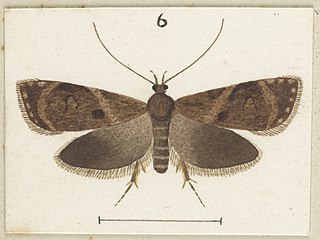Related Research Articles

Arsacia is a monotypic moth genus of the family Noctuidae. Its only species is Arsacia rectalis. Both the genus and species were described by Francis Walker, the genus in 1866 and the species in 1863. It is found from the Indo-Australian tropics of India, Sri Lanka to Queensland and the Solomon Islands.

The skin moth is a species of tineoid moth. It belongs to the fungus moth family (Tineidae), and therein to the nominate subfamily Tineinae. It is the type species of the genus Monopis and its junior objective synonym Hyalospila. As with the common clothes moth, earlier authors frequently misapplied the name Tinea vestianella to the present species.
Ichneumenoptera chrysophanes, the clearwing persimmon borer, is a moth of the family Sesiidae. It is found from Cairns in Queensland to Canberra in the Australian Capital Territory.

Ochsenheimeria taurella, the Liverpool feather-horn or the rye stem borer, is a moth of the family Ypsolophidae.

Simplicia cornicalis is a litter moth of the family Erebidae. The species was first described by Johan Christian Fabricius in 1794. It is found in south-eastern Asia and the Pacific. Records include New Caledonia, Réunion, Thailand, Fiji, Hawaii, India, Sri Lanka, the Society Islands, as well as New South Wales and Queensland in Australia. It is an introduced species in southern Florida and Louisiana in the United States.
Exelastis rhynchosiae is a species of moth in the genus Exelastis, known from Arkansas and Florida in the United States. It is restricted to specific habitats with dry or well drained sandy soils such as pine flatwoods, pine-turkey oak sandhills, sandy open areas of high live oak hammocks, or sand pine-evergreen scrub on ancient dunes where the hostplants grow.

Izatha attactella is a moth of the family Oecophoridae. This species is endemic to New Zealand, where it is known from both the North and South Islands as far south as mid-Canterbury. Larvae of this species feed on the soft inner surface of the bark of dead trees and shrubs. Adults have been recorded from September to December.

Izatha austera is a species of moth in the family Oecophoridae. It is endemic to New Zealand. The larvae of this species feed on dead wood by tunnelling into branches of its host species. The larvae matures from September and is on the wing in the months of December to January. The adult moth is variable in colouration but is seldom observed.

Hellinsia inquinatus is a moth of the family Pterophoridae. It is found in North America, including Florida, Mississippi, Oklahoma, Tennessee, Maryland, Alabama, Texas, Missouri, Colorado and Arizona. It has also been recorded from Hispaniola, Mexico, Puerto Rico and St. Thomas Island.

Hydrillodes lentalis is a species of moth of the family Erebidae described by Achille Guenée in 1854. It is found in south-east Asia and Australia (Queensland).

Phaulernis dentella is a moth of the family Epermeniidae found in Asia and Europe. The moth was first described by Philipp Christoph Zeller in 1839.
Acleris flavivittana, the multiform leafroller moth, is a species of moth of the family Tortricidae. It is found in North America, where it has been recorded from Georgia, Illinois, Indiana, Kentucky, Maine, Maryland, Massachusetts, Michigan, New Brunswick, New Hampshire, New Jersey, New York, North Carolina, Ohio, Ontario, Pennsylvania, Quebec, Tennessee, Vermont, Virginia, Washington, West Virginia and Wisconsin.
Acleris busckana is a species of moth of the family Tortricidae. It is found in North America, where it has been recorded from Maine, Manitoba, Massachusetts, New Brunswick, New Hampshire, Ohio, Ontario, Quebec and West Virginia.

Pubitelphusa latifasciella, the white-banded telphusa moth, is a moth of the family Gelechiidae. It is found in North America, where it has been recorded from Alabama, Arkansas, Florida, Georgia, Illinois, Indiana, Kansas, Kentucky, Louisiana, Maryland, Minnesota, Mississippi, Missouri, New Jersey, New York, North Carolina, Ohio, Oklahoma, Ontario, Quebec, South Carolina, Tennessee, Texas, Virginia, West Virginia and Wisconsin.

Erygia apicalis is a moth of the family Erebidae first described by Achille Guenée in 1852. It is found from the Indo-Australian tropics of India, Sri Lanka to Japan, Australia and the Solomon Islands. The habitat consists of lowland areas, including dry heath forests and softwood plantations.
Dalcerides sofia is a moth in the family Dalceridae. It was described by Harrison Gray Dyar Jr. in 1910. It is found in southern Mexico, Guatemala, El Salvador, Nicaragua and Costa Rica. The habitat consists of tropical moist, tropical dry, tropical premontane wet, subtropical moist, subtropical dry and warm temperate wet forests.
Epermenia imperialella is a moth in the family Epermeniidae. It was described by August Busck in 1906. It is found in North America, where it has been recorded from Manitoba, Alberta, Iowa and Pennsylvania.
Chionodes lophosella is a moth in the family Gelechiidae. It is found in North America, where it has been recorded from Washington to California.
Pseudotelphusa acrobrunella is a moth of the family Gelechiidae. It is found in Korea, Japan and the Russian Far East.
Telphusa sedulitella is a moth of the family Gelechiidae. It is found in North America, where it has been recorded from Arizona, British Columbia, California, Oregon and Washington. In the south, the range extends to Baja California.
References
- ↑ "Scientific name search". The Global Lepidoptera Names Index. Natural History Museum.
- ↑ Moth Photographers Group at Mississippi State University
- ↑ The Canadian Entomologist 7 (11): 210
- ↑ Microleps.org
| This article on a moth of the family Elachistidae is a stub. You can help Wikipedia by expanding it. |